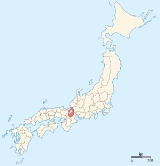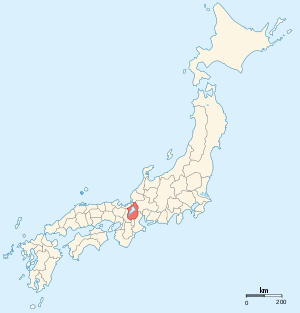
Omi Province
Encyclopedia

Shiga Prefecture
is a prefecture of Japan, which forms part of the Kansai region on Honshu Island. The capital is the city of Ōtsu.- History :Shiga was known as Ōmi Province or Gōshū before the prefectural system was established...
. It was one of the provinces that made up the Tōsandō
Tosando
was an old Japanese geographical region that made up the gokishichidō system and was situated along the central mountains of northern Honshū, Tōhoku region....
circuit
Circuit (subnational entity)
A circuit was a historical political division of China, and is still a Japanese one. In Korea, the same word is translated as "province".- China :...
. It is nicknamed as .
Lake Biwa
Lake Biwa
is the largest freshwater lake in Japan, located in Shiga Prefecture , northeast of the former capital city of Kyoto. Because of its proximity to the ancient capital, references to Lake Biwa appear frequently in Japanese literature, particularly in poetry and in historical accounts of battles.-...
, Japan's largest lake, is located at the center of the province. "Ōmi" came from awaumi or "fresh-water sea" and the kanji
Kanji
Kanji are the adopted logographic Chinese characters hanzi that are used in the modern Japanese writing system along with hiragana , katakana , Indo Arabic numerals, and the occasional use of the Latin alphabet...
of "Ōmi" means "an inlet near the capital" (See also Tōtōmi Province
Totomi Province
was a province of Japan in the area of Japan that is today western Shizuoka Prefecture. Tōtōmi bordered on Mikawa, Suruga and Shinano Provinces. Its abbreviated form name was .-History:...
).
The ancient capital was near Ōtsu
Otsu, Shiga
is the capital city of Shiga, Japan. The city was founded on October 1, 1898. As of October 1, 2010, the city has an estimated population of 338,629 with an average age of 40.7 years and a population density of 905.28 persons per km²...
, which was also a major castle town
Castle town
A castle town is a settlement built adjacent to or surrounding a castle. Castle towns are common in Medieval Europe. Good example include small towns like Alnwick and Arundel, which are still dominated by their castles...
. In north of Otsu, one of the most important monastery Enryaku-ji
Enryaku-ji
thumb|300px|Konpon Chū-dō , Enryaku-ji's main hall is a Tendai monastery located on Mount Hiei in Ōtsu, overlooking Kyoto. It was founded during the early Heian period. The temple complex was established by Saichō , also known as Dengyō Daishi, who introduced the Tendai sect of Mahayana Buddhism...
is located on the Hieizan.
Hōjō Tokimasa
Hojo Tokimasa
was the first Hōjō shikken of the Kamakura bakufu and head of the Hōjō clan. He was shikken from the death of Minamoto no Yoritomo in 1199 until his abdication in 1205.- Background: The Hōjō Clan :...
, the first shikken
Shikken
The was the regent for the shogun in the Kamakura shogunate in Japan. The post was monopolized by the Hōjō clan, and this system only existed once in Japanese history, between 1203 and 1333...
of the Kamakura Shogunate
Kamakura shogunate
The Kamakura shogunate was a military dictatorship in Japan headed by the shoguns from 1185 to 1333. It was based in Kamakura. The Kamakura period draws its name from the capital of the shogunate...
, was made daimyo of Ōmi Province in the 10th month of Shōji
Shoji
In traditional Japanese architecture, a shōji is a door, window or room divider consisting of translucent paper over a frame of wood which holds together a lattice of wood or bamboo...
2 (1200).
During the Sengoku Period
Sengoku period
The or Warring States period in Japanese history was a time of social upheaval, political intrigue, and nearly constant military conflict that lasted roughly from the middle of the 15th century to the beginning of the 17th century. The name "Sengoku" was adopted by Japanese historians in reference...
, the northern part of the province was the fief of Ishida Mitsunari
Ishida Mitsunari
Ishida Mitsunari was a samurai who led the Western army in the Battle of Sekigahara following the Azuchi-Momoyama period of the 17th century. Also known by his court title, Jibunoshō...
, Tokugawa Ieyasu
Tokugawa Ieyasu
was the founder and first shogun of the Tokugawa shogunate of Japan , which ruled from the Battle of Sekigahara in 1600 until the Meiji Restoration in 1868. Ieyasu seized power in 1600, received appointment as shogun in 1603, abdicated from office in 1605, but...
's opponent at the Battle of Sekigahara
Battle of Sekigahara
The , popularly known as the , was a decisive battle on October 21, 1600 which cleared the path to the Shogunate for Tokugawa Ieyasu...
, although he spent most of his time in Osaka Castle
Osaka Castle
is a Japanese castle in Chūō-ku, Osaka, Japan.Originally called Ozakajō, it is one of Japan's most famous castles, and played a major role in the unification of Japan during the sixteenth century of the Azuchi-Momoyama period.-Description:...
administering the fief of Toyotomi Hideyoshi
Toyotomi Hideyoshi
was a daimyo warrior, general and politician of the Sengoku period. He unified the political factions of Japan. He succeeded his former liege lord, Oda Nobunaga, and brought an end to the Sengoku period. The period of his rule is often called the Momoyama period, named after Hideyoshi's castle...
's young son. After Ishida's defeat, Tokugawa granted the fief to his allies, the Ii clan
Ii clan
The ' is a Japanese clan which originates in Tōtōmi Province. It was a retainer clan of the Imagawa family, and then switched sides to the Matsudaira clan of Mikawa Province. A famed 16th century clan member, Ii Naomasa, served as one of Tokugawa Ieyasu's generals, and received the fief of Hikone...
, who built the castle and town of Hikone
Hikone, Shiga
is a city located in Shiga, Japan. The city was incorporated on February 11, 1937.Hikone's most famous historical site is Hikone Castle. Its construction was begun in 1603, by Ii Naokatsu, son of the former lord, Ii Naomasa, but was not completed until 1622...
from the ruins of Sawayama.
Takebe taisha
Takebe Taisha
is a Shinto shrine located at Ōtsu in Shiga Prefecture, Japan. The shrine is also known in Japanese as .-History:The shrine was established in the 43rd year of the reign of the legendary Emperor Keiko, shortly after the death of his son Yamato Takeru.The shrine became the object of Imperial...
was designated as the chief Shinto shrine (ichinomiya) for the province.

Edo period
The , or , is a division of Japanese history which was ruled by the shoguns of the Tokugawa family, running from 1603 to 1868. The political entity of this period was the Tokugawa shogunate....
, it was host to five stations
53 Stations of the Tokaido
The are the rest areas along the Tōkaidō, which was a coastal route that ran from Nihonbashi in Edo to Sanjō Ōhashi in Kyoto.-Stations of the Tōkaidō:...
of the Tōkaidō
Tokaido (road)
The ' was the most important of the Five Routes of the Edo period, connecting Edo to Kyoto in Japan. Unlike the inland and less heavily travelled Nakasendō, the Tōkaidō travelled along the sea coast of eastern Honshū, hence the route's name....
and eight stations
69 Stations of the Nakasendo
The are the rest areas along the Nakasendō, which ran from Nihonbashi in Edo to Sanjō Ōhashi in Kyoto. The route stretched approximately and was an alternate trade route to the Tōkaidō.-Stations of the Nakasendō:...
of the Nakasendō
Nakasendo
The , also called the , was one of the five routes of the Edo period, and one of the two that connected Edo to Kyoto in Japan. There were 69 stations between Edo and Kyoto, crossing through Musashi, Kōzuke, Shinano, Mino and Ōmi provinces...
.
The southern part of the province around the town of Kōka
Koka, Shiga
is a city located in the southern part of Shiga Prefecture, Japan....
(Koga) was the home of the famous Koga Ninja
Koga-ryu
Kōka-ryū is a historical school of ninjutsu. It originated from the region of Kōka...
, one of the two main founding schools of ninjutsu
Ninjutsu
or may be:*the arts associated with espionage and assassination in feudal Japan, see Ninja*modern schools of martial arts claiming to be based in these traditions, see Modern Schools of Ninjutsu*fictional depictions, see Ninja in popular culture...
.

